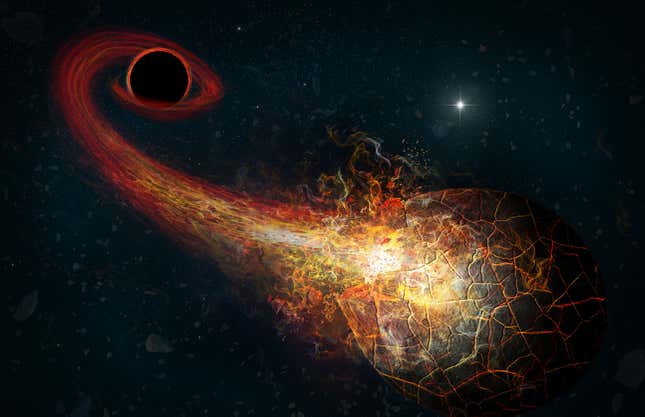
You may have heard about Planet Nine—a hypothetical planet thought to exist in the outer reaches of the solar system. One possibility is that it’s not a planet at all but a tiny black hole. New research outlines a potential strategy for detecting this supposed black hole, in a search that could begin as early as next year.
Harvard astronomers Avi Loeb and Amir Siraj have proposed a new strategy for detecting a grapefruit-sized black hole in the outer solar system, in a paper that has been accepted for publication in The Astrophysical Journal Letters. Using the Vera C. Rubin Observatory, still under construction in Chile, astronomers could indirectly detect this object by observing it do what black holes do best: gobble up stuff.
The reason for thinking a black hole might be lurking out there has to do with an unexplained set of astronomical observations. Something—we don’t know what—appears to be affecting a group of objects beyond the orbit of Neptune. A possible explanation is an undetected planet, dubbed Planet Nine, with a mass between 5 and 10 Earth masses and in an elongated orbit between 400 and 800 AU from the Sun, in which 1 AU is the average distance from the Earth to the Sun. Recently, scientists proposed another explanation: a primordial black hole of a similar mass.
That we could have an ancient black hole inside our solar system is not as outlandish as it might sound. As Loeb explained to Gizmodo, it’s possible that primordial black holes are responsible for what scientists think is dark matter in the universe. If that’s the case, there should be a tremendous number of black holes out there, so it’s not foolish to think one of them got trapped in our solar system.
“This will obviously be extremely exciting, since we have been searching for the nature of the dark matter for nearly half a century,” wrote Loeb in an email to Gizmodo. “If the black hole is the dark matter, there should be 50 quadrillion like it in the Milky Way alone to make the entire mass of the Milky Way galaxy, which weighs a trillion solar masses.”
A quadrillion, by the way, is a 1 followed by 15 zeros.
Finding an object with an event horizon the size of a grapefruit sounds daunting, but these massively heavy objects can wreak havoc in their local environment. This is exactly what Loeb and Siraj are counting on, as the hypothesized black hole should suck up the occasional Oort cloud object, namely comets.
Caught in the black hole’s clutches and steadily drawing nearer to its doom, a comet should start to melt as it interacts with hot gases accumulating in the area. This process should produce a radiation signature detectable from Earth, which the scientists refer to as an accretion flare.
“Our paper shows that if Planet 9 is a black hole, then comets residing in the outskirts of the solar system—the so-called Oort cloud—would impact it, get destroyed by its strong gravitational tide, and produce a flare as they accrete onto it quickly, within less than a second,” Loeb told Gizmodo.
If the comet is big enough, it should be detectable through the Legacy Survey of Space and Time (LSST), which is set to start next year at the Rubin Observatory. This telescope is ideal for the task owing to its exceptionally large field of view. Astronomers have only a very rough idea of where they should look for Planet Nine or the black hole, but LSST will cover half of the sky and make 824 repeat visits to each spot over a 10-year period.
“If Planet 9 is a black hole, we expected to see at least a few flares about a year after LSST starts surveying the sky,” said Loeb.
This isn’t the first proposal for sniffing out a potential black hole. Earlier this year, Edward Witten, a physicist at the Institute for Advanced study, devised a proposal in which hundreds of spacecraft would be sent to the outer solar system. Changes to their sensitive clocks would signal the presence of a strong gravitational field produced by a tiny black hole. Sounds cool, but the new proposal from Loeb and Siraj is more practical.
“If indeed it turns out to be a plausible strategy, the idea that Loeb and Siraj are presenting is really nice,” Jakub Scholtz, a postdoc at the Institute for Particle Physics Phenomenology at Durham University in the UK, told Gizmodo. “It would be a game changer for Planet Nine as a primordial black hole scenario.”
Scholtz, along with his colleague James Unwin from the University of Illinois at Chicago, published a paper last year arguing that Planet Nine might actually be a black hole. He said the odds of our solar system capturing a black hole are about 50-50, so if the authors can test this, “we should go ahead and do so.”
Either way, the LSST project will produce meaningful results, as the absence of black hole evidence could point to other possibilities, such as Planet Nine actually being a planet. The mind boggles at how much we still don’t know about our own solar system.